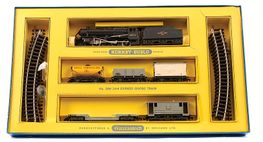
The Home of Model Railways
First introduced in 1920, Hornby has become the brand leader of '00' Gauge model railways in GreatBritain. Throughout its long history, Hornby has produced iconic sets, highly detailed locomotives and more. The Hornby name first appeared in 1909 on an educational Meccano set called 'Hornby System of Mechanical Demonstration'.
The first railway product was introduced in 1915 under the name 'Raylo'. The Hornby name was not used to market a loose track model railway system until 1920. In 1938, Hornby Dublo was introduced, which later became the company's main model railway product in the 1950s. By 1981, Hornby became an independent company and started the journey to where you see the brand today.
Many train journeys have been taken since 1920, with model railways enthusiasts from all walks of life. With new ideas and technology continuing to progress the hobby, Hornby is looking forward to a new era of model railways.
With special thanks to Simon Kohler, Pat Hammond and The Hornby Book of Trains - The First One Hundred Years which covers the history and the products of an iconic British brand.

Introduction
The iconic British brand began with Frank Hornby and his passion for inventing, which led him to create educational toys for his sons. In 1901, the name 'Mechanics Made Easy' was patented and began the foundation for the Meccano company.
Containing 16 individual parts, the sets went on sale in 1902. By 1907, the Meccano name was registered and the educational toys were being produced at a workshop in Liverpool. The following year, Meccano became a limited company and Hornby's partner David Elliott decided to retire from the partnership.
With production periodically moving to larger facilities to accommodate the company's growth, Frank Hornby launched the Meccano Magazine in 1916. The Meccano Magazine proved popular with continuous growth over the years. By 1920, new Meccano products were advertised including the announcement of 'the finest series of clockwork railway trains ever made', paving the way for over 100 years of Hornby history.
+ Click image to view full-size
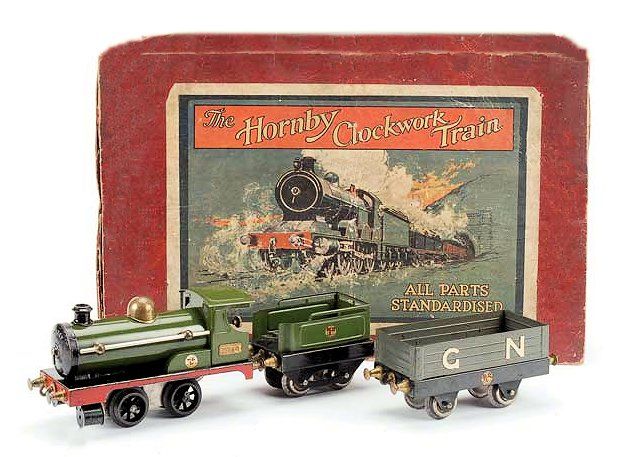
1920 - 1930
The development of Hornby
- In the 1920s, the Hornby Clockwork Train Sets became the first in a long line. These sets were available in three liveries and featured an 0-4-0 locomotive, paving the way for the hobby.
- Growth occurred rapidly for the brand, with the first years of the century seeing an ever-increasing range of sets, locomotives, wagons, coaches, scenic accessories and more.
- Electric versions of the popular train sets were introduced in 1925, using a 20V AC system which was later replaced by a lower voltage controller. The locomotive was also the first by Hornby to feature a body modelled on a real prototype.
- In 1928, the organisation formed a membership scheme known as 'The Hornby Railway Company', which gained 12,000 members by the end of the year.
c. Hornby No.1 first GNR train set (1920) (unknown source)
+ Click image to view full-size
1930 - 1940
The birth of Hornby Dublo
- The 1930s saw a gradual focus on more authentic liveries. Young enthusiasts were looking for realism, following the success of the No.2 Special locomotives.
- During the decade, the system went from 20 V AC to Hornby Dublo 12 V DC. This paved the way for electric track parts and lineside accessories, including lighting. Any customers without mains electricity still had the option of the 6 V accumulator system.
- In 1936, Frank Hornby passed away and Roland Hornby became Chairman. Two years later, Hornby Dublo was launched and the expansion of '0' gauge slowed.
- The initial Hornby Dublo range was both clockwork and 12vDc powered and all used either die-casting or tinplate in construction. The sale of clockwork models ceased after the Second World War.
c. Hornby Dublo catalogue for 1938-39 (Pat Hammond)
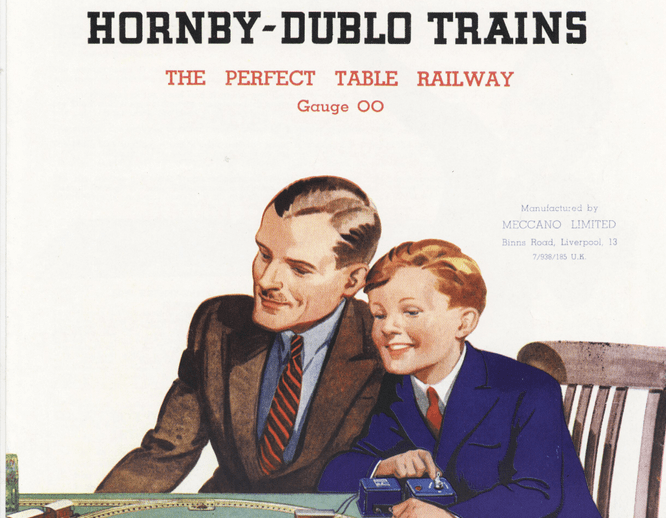
+ Click image to view full-size
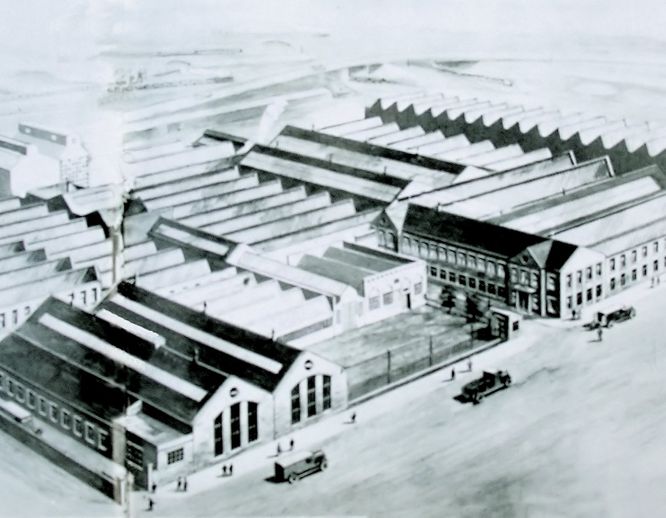
1940 - 1950
During the Second World War
- Despite the Second World War which began in 1939, production of most product lines continued until 1941. Sales were ended by government order in 1943.
- Following the end of the Second World War in 1945, Hornby Dublo remained low in the company's priorities. The following year saw releases for '0' gauge sets, Dinky Toys and Meccano sets.
- The year 1946 saw the formation of Rovex Plastics Ltd. The company released the Rovex train set in 1950 and would later become Hornby Dublo's biggest rival.
- By 1947, Hornby Dublo sets were back on sale, as well as new '0' gauge sets with more authentic liveries on re-issued '0' gauge wagons. Several new lineside accessories were also made available.
c. Meccano Ltd Factory Binns Road, Liverpool (Meccano Ltd)
+ Click image to view full-size
1950 - 1960
The product evolution
- Meccano Ltd. experienced difficulties with metal shortages in the 1950s. The Korean War meant little product could be made, with Hornby Dublo aluminium buildings the only exception.
- By 1954, Hornby Dublo received its first completely new post-war locomotive. The standard 2-6-4T locomotive was also introduced alongside suburban coaches and an expanding wagon range.
- Competitor Tri-ang Railways completed a modern and highly efficient factory in Margate, Kent. This would later become the home of Hornby for many years, including to this very day.
- By the end of the decade, Hornby Dublo introduced two-rail locomotives and track. This project was not without its hardships as the designs were far too complicated.
c. New Rovex factory, Margate first phase (1954) (Lines Bros.)

+ Click image to view full-size
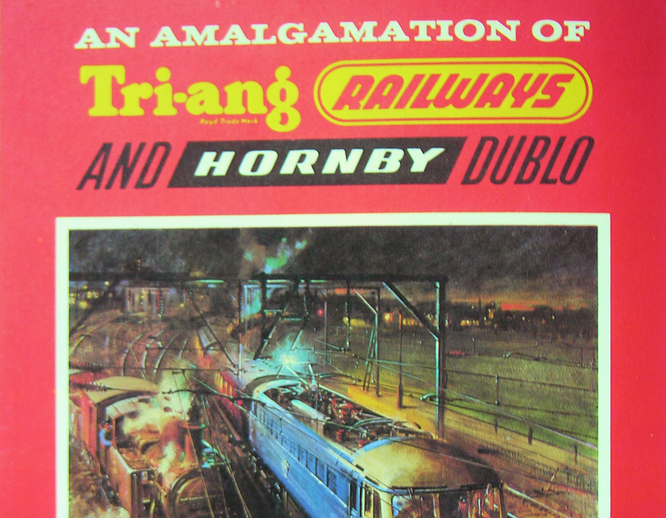
1960 - 1970
The Tri-ang Hornby era
- Although the Hornby Dublo range continued to expand in the early 1960s, competition became a problem with multiple manufacturers releasing train sets at a fraction of the price.
- Hornby '0' gauge ceased development while the Hornby Dublo range gained a revolutionary new ringfield motor. But despite the product growth, Meccano Ltd were facing financial trouble.
- By 1964, Meccano Ltd. joined Lines Group and the following year saw the two rivalled systems merged under the name Tri-ang Hornby.
- Rovex Industries Ltd. was formed as an umbrella company in 1967. The Margate factory saw products from many different markets passing through the production line, including products from overseas.
c. The 1965 'Amalgamation' leaflet (Rovex)
+ Click image to view full-size
1970 - 1980
Gentle revival of model railways
- Despite Tri-ang Railways being a reasonably successful member of the group, Line Bros. collapsed in 1971. The following year Dunbee-Combex-Marks Group (DCM) took over and renamed the model railway system 'Hornby Railways'.
- The 1970s saw a move into pre-BR liveries which gave a new lease of life to model railways. However, earlier moulds were showing signs of wear and a restricted budget led to lower standards.
- By 1977, plans were made to implement greater authenticity, resulting in a selection of models ready to contend with the competition.
- At the end of the decade, the live steam 3.5 inch gauge Rocket was showcased as an impactful exhibition model, gaining lots of publicity. Despite over 20,000 sets being made, development costs were not covered.
c. Hornby live steam 'Rocket' and rare shop display unit (1979) (Pat Hammond)

+ Click image to view full-size

1980 - 1990
Hornby Railways becomes Hornby Hobbies
- Following the ambitious attempt to break into the American market, Dunbee-Combex-Marx entered into receivership in 1980. This resulted in a management buyout and the business becoming a public limited company.
- The decade also saw the introduction of tools with changeable inserts, which accounted for physical differences between locomotives - an essential development for customers requiring more accuracy.
- Hornby Hobbies received royal attention in 1984 when HM the Queen received the 'Starlight Express' locomotive with themed livery.
- The mid-1980s offered greater variety with new names, liveries and running numbers to accommodate the demands of the model railway buying public.
c. 'Starlight Express' presentation to the Queen (1984) (Hornby Hobbies)
+ Click image to view full-size
1990 - 2000
The move to the Far East
- In the early 1990s, the company tended to focus on marketing a range of toys at the expense of its historically successful model brands.
- This decade also saw the lowest investment in new tooling, which was later improved by the acquisition of former Airfix and Dapol tools.
- By the mid-1990s, the company had been facing stiff competition which led to a cease of production in the UK. The move to the Far East took four years to complete and saw the closure of the Hornby Margate factory.
- The end of the decade saw a positive impact on sales, thanks to the super detailed model locomotives delivered from the Far East.
c. 1995 Hornby Railways date wagon (Pat Hammond)

+ Click image to view full-size

2000 - 2010
Steaming ahead
- The New Millennium paved the way for the expansion of Hornby. The range was now larger than ever, offering hundreds of locomotives, coaches, wagons and more.
- The recent move to China produced a new standard of modern model production. The '00' gauge Bulleid rebuilt 'Merchant Navy' 4-6-2 was an outstanding model - a turning point in Hornby model production.
- On the theme of innovation, the company also launched 'Live Steam'. Models produced real steam through an immersion heater in the tender. Production began with sets and moved towards individual models to allow customers to expand their fleet of Live Steam locomotives.
- The 2000s also saw the introduction of RailRoad (a new budget series), Skaledale, SkaleAutos, SkaleScenics and SkaleLighting (all large ranges of accessories and materials for enthusiasts).
c. Hornby live steam scene (Hornby Hobbies)
+ Click image to view full-size
2010 - 2020
Temporary relocation
- Following a successful decade in the 2000s, in the mid-2010s the company decided to close the Margate factory site and outsource the distribution to a facility in Hersden, Kent.
- The same year, the offices were also relocated to Discovery Park in Sandwich, Kent. Despite the move, the Visitor Centre remained on site.
- Just four years later, the office returns to the original 1954 Margate site to rejoin the Visitor Centre.
- The 2010s saw ample management changes, overcoming mistakes and consistently attempting to improve the products and turn the business around.
c. Hornby Visitor Centre (2010) (Pat Hammond)

+ Click image to view full-size

2020 - Present
Celebrating 100 years
- With a pandemic on the rise in 2020, a new normal consisted of social distancing and staying at home, which meant more time to pick up old hobbies.
- With a nation inspired to rediscover childhood hobbies, Hornby sets found their way out of the loft and model railway fans experienced true nostalgia, passing their passion down the generations.
- Rather fittingly, 2020 was also the centenary year. Hornby celebrated 100 years with a range of limited-run models and a whole host of special content online.
- With model railways making their way into modern life, Hornby continues to innovate and keep the hobby relevant for the experienced modeller as well as the new generation of young railway enthusiasts.
c. The Hornby 100 Takeover Lifetimes Journey Outtakes (Hornby Hobbies)
+ Click image to view full-size
Browse the range
Don't hesitate to become part of our history, discover the full Hornby range today.
Shop now














































































